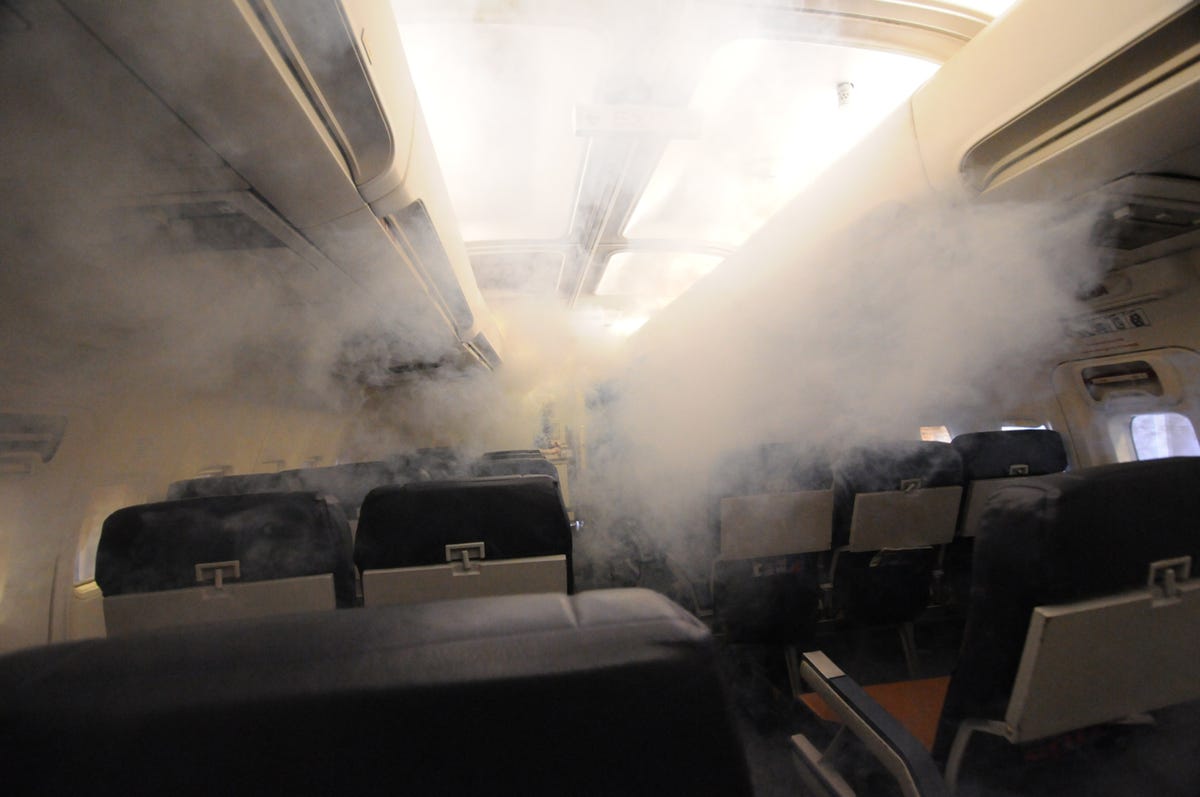Behind the scenes at Southwest Airlines (pictures)
One of the world's most profitable airlines, Southwest centralized its training operations in Dallas, and added a giant new network operations center. CNET Road Trip 2014 buckled up and checked it out.

Smoke-filled cabin
DALLAS -- If you've ever flown, you've doubtless sat through the list of emergency procedures at the beginning of the flight. But did you listen?
Southwest Airlines flight attendants don't have the luxury of tuning out when they're training for their jobs, especially not when learning how to handle an onboard emergency like a fire.
At its Dallas headquarters, Southwest runs this cabin trainer, known as the Poolie, which lets the flight crew practice what to do in a crisis.
As part of Road Trip 2014, CNET reporter Daniel Terdiman stopped in on the airline's headquarters and, among other things, got treated to the emergency-training experience.
Poolie from the side
Southwest bought the cabin trainer, which mimics part of the interior of a Boeing 737, from Carnival Airlines in 1985. The airline repainted the trainer with its new livery last year.
No smoke in your eyes
The interior of the Poolie just prior to the cabin filling up with fake smoke. As you can see, it looks very much like an older Southwest 737.
Poolie with slide
Part of the emergency exercise for those training in the Poolie is to guide "passengers" down the slide that inflates in the case of a crisis. Here, we see the trainer with the slide extended after a demonstration. The exit door had been open during the demo.
Flight simulators
Southwest maintains nine flight simulators at its Dallas headquarters. All first officers and captains must train in them once a year. The giant simulators are meant to pitch and roll just as a plane would, depending on the scenario. The nine simulators are almost always all in use.
All electric simulators
While most of the flight simulators use hydraulics to move, the airline's two newest are all-electric. All nine of the trainers simulate Boeing 737s, although two of them (not pictured here) represent the oldest 737s in the airline's fleet.
Good luck chicken
Each of the nine simulators has a rubber chicken hanging from it somewhere. Though not an airline industry standard, at Southwest, the practice is thought to bring pilots good luck.
Author in the flight simulator
The author sits in one of the pilot's seats in the flight simulator, ready to take on the virtual skies.
Ready for takeoff
A look out the "window" of the flight simulator cockpit at the virtual runway. The simulator can test any number of scenarios, including taking off with a burning engine, landing in low visibility, approaching big airports, or just about anything else.
Banking over Seattle
CNET reporter Daniel Terdiman banks to the right over "downtown Seattle" in the Southwest Airlines flight simulator.
Lobby models
In the lobby of Southwest's main headquarters building, a set of scale-model Boeing 737s hangs from the ceiling, each representing a livery the airline is currently flying.
Nose photo opp
Scattered around the airline's headquarters are a set of "photo ops," like this one, where employees and visitors are invited to stop and pose for a photograph.
Working on the bridge
One of Southwest's big new initiatives is this giant center, the NOC, or network operations center. Here, representatives from most of the airline's departments work in small teams to dispatch and monitor each and every one of its daily flights. Here, we see supervisors monitoring flights on the "bridge," the raised area in the middle of the center where senior members of the teams sit and work.
NOC
A look at the NOC from the rear of the room. Southwest built the center with plenty of room to expand.
Trying to route around weather
A dispatcher's computer screen shows that the intended route for a Baltimore to Salt Lake City flight would take it through a giant set of thunderstorms. His challenge is to find an efficient route around the 55,000-foot-tall thunderheads.
Engine cowling
Another photo op inside Southwest's headquarters is this engine cowling.
Big plane in TOPS lobby
Southwest recently opened a giant new facility across the street from its main headquarters. Known as TOPS, or Training and Operations, the building is home to the airline's entire training program, which used to be distributed around the country. This large scale-model Boeing 737 hangs in the TOPS lobby.
Listening center word cloud
Recently, Southwest opened what it calls its "Listening Center." Designed to help its communications department monitor social-media channels throughout the day, the idea is that it can react to many types of customer complaints or questions, or to unfolding events much faster than using traditional methods.
One way it does so is by looking to see what the most common phrases being used in conjunction with the airline's name are at any time. The result is this word cloud.
Listening center
A look at the listening center, which has room for several employees, and several different kinds of information being represented on its many screens.
Training check-in counter
It may look just like an airport's Southwest Airlines check-in counter, but in fact this is a mock-up of one in the airline's training center.
Door training
Groups of trainees are taught how to open the plane's doors in an emergency using this mock-up, in one of the training rooms.
Southwest U class list
A video screen shows a partial list of the current training classes being offered around the building at "Southwest U."

